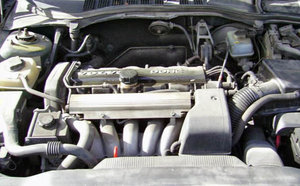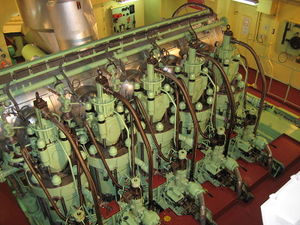Straight-5
The straight-5 or inline-5 is an internal combustion engine with five cylinders aligned in one row, sharing a single engine block and crankcase. This configuration is a compromise between the smaller straight-4 and the larger straight-6.
Straight-5 engines have been used rarely but continuously since their invention. In recent years they have become increasingly popular. They are used in Audis and on some diesel-powered Mercedes-Benz models, as well as on the Acura Vigor. Recently, General Motors launched a popular straight-5 engine for its compact trucks (Chevrolet Colorado, GMC Canyon, and the Isuzu i-350). It also powers the Hummer H3. The engine is part of its Atlas family that also includes 4- and 6-cylinder versions. Since the Volvo 850 was introduced in 1991, many Volvos make use of straight-5 engines, often turbocharged. It has also recently found an application in the Ford Focus ST. Volkswagen has used straight-five engines in their Eurovan, and have recently developed a different straight-five engine which is used in the Jetta and Golf/Rabbit. Also Fiat make use of their superb 5-cylinder engines (both petrol and diesel) in big Fiat and Lancia models.
Characteristics
The 5-cylinder engine's advantage over a comparable 4-cylinder engine is best understood by considering power strokes and their frequency. A 4-cycle engine fires all its cylinders in every 720 degrees — the crankshaft makes two complete rotations. If we assume an even firing engine, we can then divide 720 degrees by the number of cylinders to determine how often a power stroke occurs. 720 degrees ÷ 4 = 180 degrees, so a 4-cylinder engine gets a power stroke every 180 degrees. A V8 engine gets a power stroke every 90 degrees, (720° ÷ 8 = 90°).
A given power stroke can last no more than 180 degrees of crankshaft rotation, so the power strokes of a 4-cylinder engine are sequential — no overlap. At the end of one cylinder's power stroke another cylinder fires.
In a 1-, 2-, or 3-cylinder engine there must then be times when no power stroke is occurring. A 3-cylinder engine gets a powerstroke every 240 degrees, (720° ÷ 3 = 240°). Since a power stroke cannot last longer than 180 degrees, this means that a 3-cylinder engine has 60 degrees of "silence". No power stroke occurs, there is no overlap.
A 5-cylinder engine gets a power stroke every 144 degrees, (720° ÷ 5 = 144°). Since each power stroke lasts 180 degrees, this means that the power strokes have some overlap and the engine is smoother than a non-overlapping 4-cylinder engine.
A 5-cylinder engine also gains smoothness over a 4-cylinder engine because there is not a moment in a 5-cylinder engine when all pistons reverse direction at the same time. A typical inline-4 has the center pistons rising and falling together and the outer pistons rising and falling together. When pistons #1 and #4 are at top dead center (TDC), #2 and #3 are at bottom dead center (BDC).
Every cylinder added beyond five increases the overlap of firing strokes and makes for a smoother engine. An inline-6 gets a power stroke every 120 degrees. So there is more overlap (180° - 120° = 60°) than in a 5-cylinder engine (180° - 144° = 36°). However, this increase in smoothness of a 6-cylinder engine over a 5-cylinder engine is not as pronounced as that of a 5-cylinder engine over a 4-cylinder engine. The inline-5 loses less power to friction as compared to an inline-6. It also uses fewer parts, and it is physically shorter, so it fits under the bonnet better, allowing for transverse mounting.
The 5-cylinder engine is longer and more expensive to manufacture than a comparable 4-cylinder engine, but some manufacturers feel these costs are outweighed by the 5-cylinder engine's greater smoothness.
Automobile use
The smallest production straight-5 was found on the 1981 Audi 100, with 1921 cc of displacement. The Toyota 1PZ Diesel is the largest at 3469 cc, though the aforementioned GM Atlas is close at 3464 cc.
Motorcycle use
The smallest straight-5 was found on the Honda racing motorcycle, the 125cc RC149, raced in 1966. The five cylinder configuration was used because it shared components (and hence simultaneous development) with the 2-cylinder engine, 50cc, RC116.
| Piston engine configurations | |
|---|---|
| Straight | Single, 2, 3, 4, 5, 6, 8, 9, 10, 12, 14 |
| V | 2, 4, 5, 6, 8, 10, 12, 16, 20, 24 |
| Flat | 2, 4, 6, 8, 10, 12, 16, H |
| W | 8, 9, 12, 16, 18 |
| Other inline | H, VR, Opposed, U (Square), X |
| Other | Hemi, Radial, Rotary, Pistonless, Deltic, (Wankel) |
| Heat engines | |
|---|---|
| Stroke cycles One • Two • Four • Six • | |
| Engine types Gas turbine • Piston • Jet • Rocket engine • Steam engine • Stirling engine • Tschudi• Twingle Rotary • Wankel • Free-piston • Britalus • Coomber • Swing-piston • Orbital • Quasiturbine | |
| Valves Cylinder head porting • D slide • Four-stroke • Manifold • Multi • Piston • Poppet • Sleeve | |
| Piston layouts Single cylinder • Straight • Opposed • Flat • V • W • H • Deltic • Radial • Rocket engine nozzle • Rotary • Stelzer • Controlled Combustion • Bourke | |
| Motion mechanisms Cam • Connecting rod • Coomber rotary • Crank • Crank substitute • Crankshaft • Linkages (Evans • Peaucellier-Lipkin • Sector straight-line • Watt) • Double acting/differential cylinder | |
| Thermodynamic cycle |

